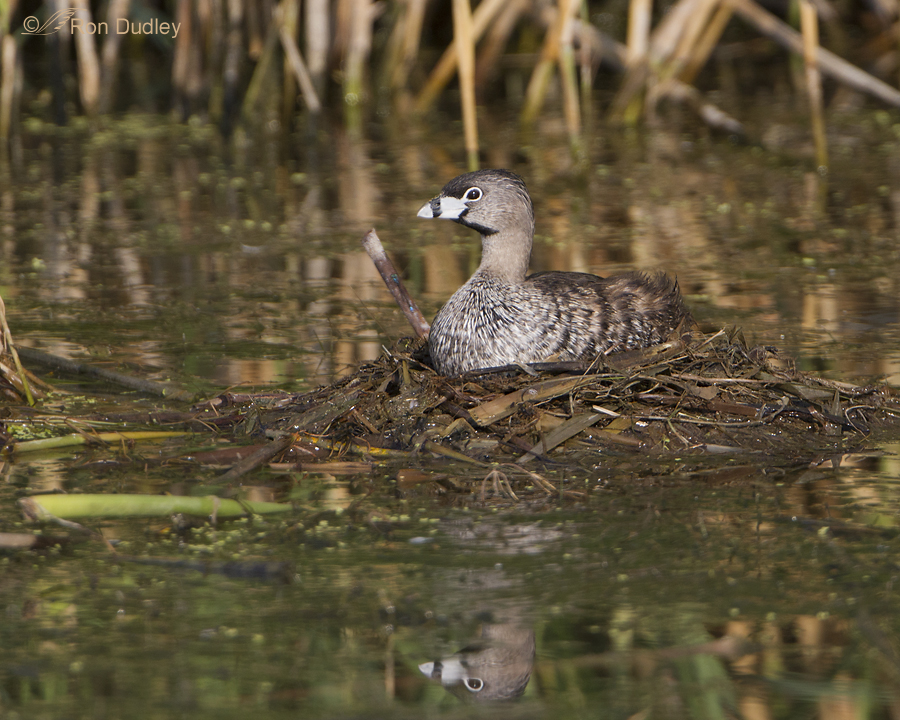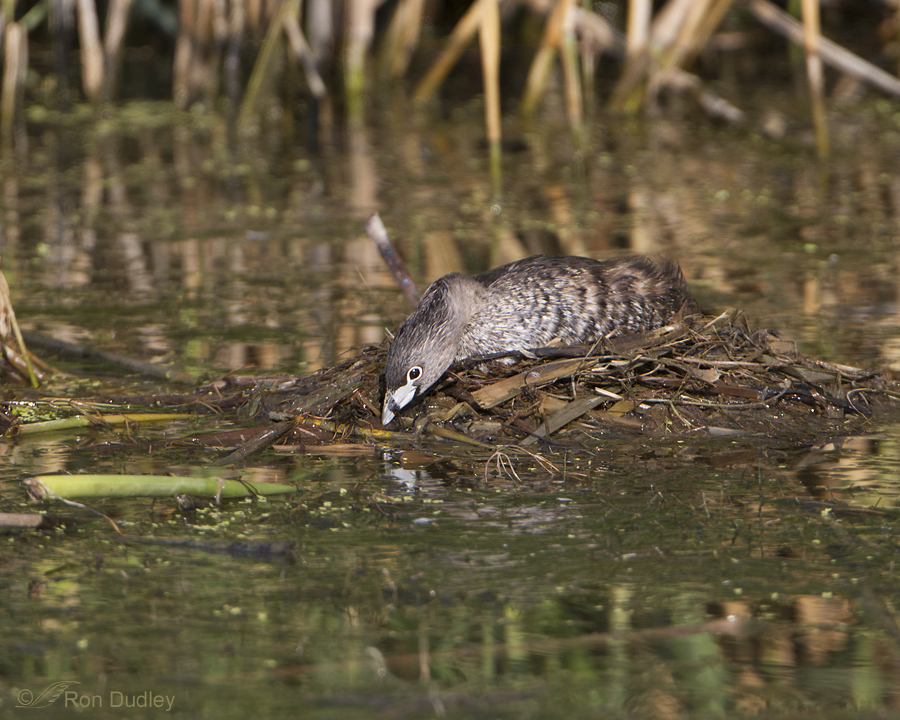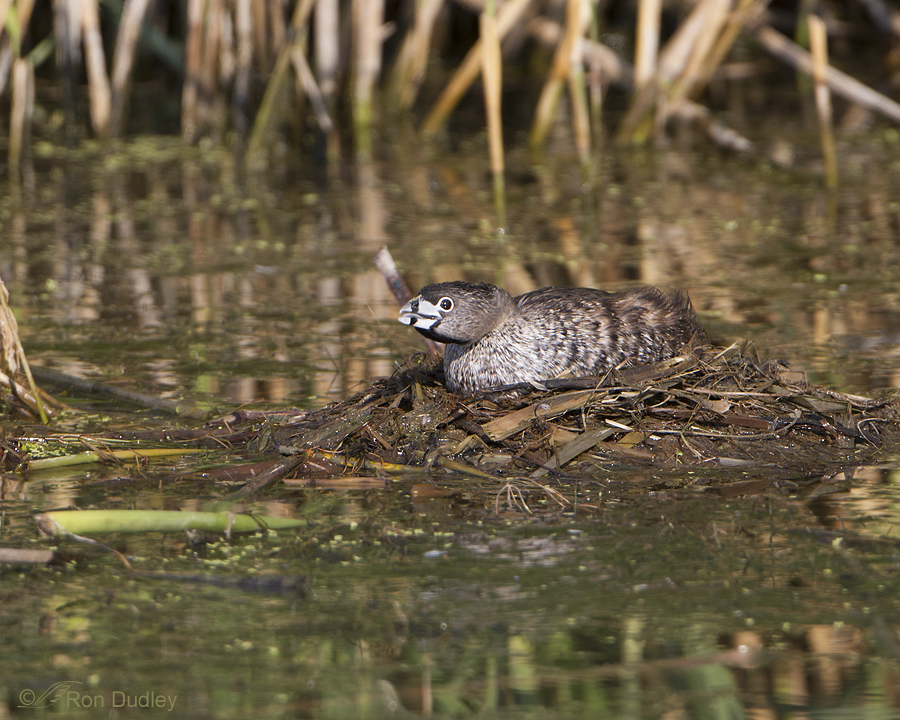Pied-billed Grebes are common breeders in my area but I’ve seldom seen them on the nest. Many if not most nests are built among tall, emergent vegetation and seldom seen by humans. Some are constructed in open water which makes them easier to spot but on the rare occasions when I’ve been able to see one it’s been much too far away for decent photographs.
Their nests are floating platforms that are usually anchored to emergent vegetation and constructed of dead or rotting plant material. These birds often leave the nest and eggs unattended for extended periods of time and it is thought the rotting vegetation supplies some or all of the warmth required to keep the eggs viable in the absence of the adults.
1/1600, f/6.3, ISO 500, 500 f/4, 1.4 tc, natural light
Yesterday morning I was very surprised to see this active nest so close to the loop road at Bear River Migratory Bird Refuge. Both parents incubate and the sexes are similar so I don’t know if this was the male or the female but the apparent mate of this bird was hanging around in the general vicinity.
1/1250, f/7.1, ISO 500, 500 f/4, 1.4 tc, natural light
There wasn’t much action or interesting behavior going on but occasionally the bird would reach down to the surface of the water for a drink…
1/1250, f/7.1, ISO 500, 500 f/4, 1.4 tc, natural light
and then tip its head back and open its bill to let the water run down its throat.
Pied-billed Grebes have an unusually long breeding season which may last into October so perhaps I’ll have more opportunities with them during nesting activities this summer. But based on my track record with the species at the nest, these photos will likely have to do…
Ron
Note: This nesting bird was not disturbed. I was on a regularly used road and I never got out of my vehicle during my session with the grebe. It showed no signs of nervousness.





Great shots Ron. We have a couple of Pacific Loon nests only feet from busy roads up here. Silly birds, but perhaps such a strategy keeps the foxes at bay? I hope you have some more success with these guys at their nests.
Great shots as usual. I love the beak on this bird. I am keeping my fingers crossed that the eggs hatch safely and make it to fledge. Thank you.
Thank you, Debbie. I believe they only have that vertical black band on their bill during breeding season.
Great find and shots Ron! Thanks for sharing!
Charlotte
Thank you, Charlotte.
Nice series of photos. I’m really glad I’m not a Grebe – I would not want to have to sit on that nest… 🙂
Looks pretty soggy, doesn’t it, Susan?
Great find Ron. I did not know that Pied-billed Grebes had such a long breeding season. Yesterday I saw many nearly adult sized Pied-billed grebelets at Ridgefield NWR, so I was surprised to see the title of your post.
John, The length of their breeding season depends on location and ice-out date but going until October is pretty interesting, isn’t it?
I find this very interesting. i’ve heard of these birds, but never seen the bird before. The construction of the nest makes me wonder how they can keep the eggs warm enough to incubate…the nest looks so wet you’d think the eggs would get too cool. ..even if there is rotting vegetation to provide warmth. I know manure pile and compost heaps can give off a lot of heat, but they aren’t “water cooled”. I wonder how warm the nest itself gets.
Patty, In answer to your question, here’s what BNA has to say on the subject:
“Rotting plant material included in grebes’ nests is thought to supply some or all of warmth for incubation of eggs or slow-down cooling of eggs in absence of adults ( Rockwell 1910, Cottam and Glazener 1959, Bochenski 1961). In Dickinson Co., IA, and San Diego and Imperial cos., CA, adult Pied-billed Grebes covered eggs and left nest unattended for prolonged periods of time. Bottom of unincubated, but covered, nest cup remained at 31–33°C despite floating in water at 20°C and being exposed to air temperatures ranging from 10.8 to 23.6°C (Jun). In hot, arid Imperial Valley, CA, as ambient (shade) air temperature rose, nest temperature rose but never exceeded 34–36°C, even when ambient air temperature exceeded 40°C ( Davis et al. 1984).”
Thanks for the reply re: the nest temp, Ron. Once again, looks can be deceiving…what looks wet and possibly too cool, apparently has an inner core temperature that actually acts as an effective incubator. I wonder if I’ll ever be smart enough NOT to doubt Mother Nature’s wisdom and effectiveness. At 80, I’ m scared that I’m running out of time to get that smart!
What a great looking bird! I have never seen one before…..:)
Thanks Ron
Tim
Thank you, Tim.